|
Let's
Jaw About Jawfish
Lately, it seems
there has been a lot of confusion about jawfish in reef aquariums.
With the advent of live sand substrates and today's popularity
of oolitic or "Southdown" sand, many hobbyists are
left with a feeling that jawfish are no longer a great reef
community fish. I completely disagree with this notion, and
will explain why as this article progresses.
About the Family
The Family Opistognathidae, otherwise
commonly known as jawfish, is comprised of three genera and
nearly 40 described species with possibly another 30 un-described.
Since Opistognathus are the most
popular genera among aquarists, Lonchopishtus, and
Stalix will not be discussed.
Roughly 23 described species bear the Opistognathus
name. Opisto comes from the Greek word opisthen, meaning
'behind,' and gnathus meaning jaw. These species are
the ones that are most often of interest to the hobbyist due
to size, availability, and coloration. Opistognathids
can be found in the western and central Atlantic, Indian,
and both coasts of the Pacific Oceans. They sport a long,
continuous dorsal fin of 9 - 12 spines, and a spine made of
three weak-branched inner rays and two stout, un-branched
rays on either end. All jawfish are mouth brooders, and all
live in a den that they dig with their mouths.
The two most commonly kept jawfish are
O. rosenblatti and O. aurifrons. I will concentrate
my discussion on these two fish. From here on in the discussion,
when I refer to "jawfish," I will mean these two
species. I will touch on a few additional species at the end.
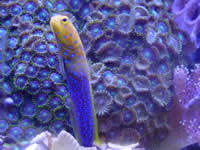 |
The
Blue Spot Jawfish. One look and you can understand why
some hobbyist don't balk at the $200 price tag. |
|
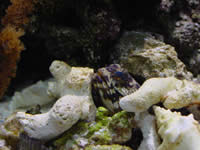
|
Dusky jawfish like this one rarely hover above their
burrow. Instead, they sit with just their head exposed,
watching the world go by, and waiting for a meal to
pass overhead.
|
Captive Care Requirements
Lately, jawfish have been getting a bad
rap when it comes to the current trend of a deep, live sand
bed. Many hobbyists complain of these fish constantly moving
sand, always building new borrows, digging to the bottom of
the tank, clearing the sand away from ½ of a tank,
or even eating the life of the sandbed. The latter is a completely
unfounded belief, and simply not true. When added to a sandbed
comprised of sand <5mm in diameter, a jawfish will do exactly
as hobbyists otherwise complain. The hobbyist is left in buyer's
remorse because the fish wreaks havoc on the sandbed, largely
due to the hobbyist not supplying the fish with adequate den
building materials.
Captive care should mirror their natural
environment as much as possible. This is not possible in most
home aquariums due to size restraints, but with good planning,
a close replica can be achieved. Jawfish are always located
on reef flats at depths ranging from 10 feet to 150 feet.
They prefer to hover up to 5' above their den, always having
a 360° view of their surroundings. Without an extensive
view in all directions, they will hang lower than usual or
may only extend their head outside their den. This reclusive
behavior also occurs when actively swimming fish are present.
Their dens range from 4 - 9" deep, extend nearly 9"
wide, are 2.5" tall, and are comprised of mostly broken
coral branches, pieces of coral limestone, bivalve and snail
shells, and assorted pieces of hard material (Michael, Coral
Realm). They feed entirely from the water column with
roughly 85% of their diet being zooplankton (Randall, '67).
So what does all this mean? Plan ahead.
Jawfish should be the first fish added to the home aquarium.
It is harder to get them acclimated once other fish are established.
This does not mean if your aquarium already has inhabitants
that you cannot keep these fish, but it does make it tougher
to acclimate them.
Assuming we are planning ahead, the ideal
sandbed for a jawfish will be at least 10 - 12" deep.
Emphasis on "ideal." Sometimes "ideal"
is not always realistic. In such cases when 12" of sandbed
is not realistic, I would consider 6" as being the absolute
minimum. This is a personal observation only. Others have
recommended a 3" sandbed as a minimum (Fenner, Wet
Web Media). When you take into consideration that the
minimum depth for a jawfish's den in the wild is 4",
a 3" sandbed seems extremely inadequate. You can use
fine grain, or "Southdown" sand, but be prepared
for the jawfish to clear away a large area on his first night.
When I say, "be prepared," I mean with appropriately
sized rubble for the jawfish to use in building its den. This
includes most any rubble larger than 10mm in width. Don't
forget to include plenty of broken coral branches, pieces
of coral limestone, bivalve and snail shells. As time goes
by the jawfish will construct a den for itself, slowly using
the rubble you supply to build its new home. As the rubble
gets used, keep replacing it with more. Soon enough, you'll
have your sandbed back in order, and the jawfish will have
it's home constructed. A nice finishing touch on the den is
usually a snail shell or its equivalent being used as a "roof"
of sorts. The jawfish will pull this "roof" over
the den entrance when it retires for the evening, and remove
it when it wakes in the morning!
Since the jawfish consumes a great deal
of zooplankton, feeding is easy. Enriched brine, mysis, plankton,
and Formula I should be readily accepted. If newcomers are
finicky eaters, it may take live brine or live blackworms
to entice a feeding response. In passive tanks the jawfish
will become an aggressive eater, actively roaming around the
tank in search of its next tasty morsel. However, in a tank
with active fish, especially those that are hyperactive at
feeding time, spot feeding with a turkey baster is most likely
going to be required.
One common myth regarding jawfish care
in our tanks, is that strong lighting should be avoided. Since
jawfishes are found throughout reef flat depths, most any
aquarium lighting will be sufficient. It is improbable that
strong lighting has any negative effects.
Bringing One Home
Your deep sandbed is ready, rockwork is
stable and supported, and you have plenty of excess rubble
on hand. Once you have the fish, follow typical acclimation
procedures. If you introduce the fish during the daylight
photoperiod, you can expect the fish to dart for rockwork.
It will usually remain hidden in the rocks for the first day,
though on occasion the daring jawfish will begin its burrow
construction. This is more common when it is the first fish
into the tank.
|
|
|
A male Opistognathus aurifrons.
|
A major concern for the newly acquired
jawfish is their tendency to jump from open top aquariums.
It is absolutely imperative that the home of a newly acquired
jawfish is covered! Some will use glass tops, but this is
usually frowned upon in the hobby for various reasons. So
some others, myself included, will use egg crate fitted over
the top of the tank. Egg crate can be found in the lighting
department of most any home improvement store. Since the holes
in the egg crate are large enough for a jawfish to slip through,
it is necessary for you to use some sort of screening or netting
laid over the egg crate. I use window screening, though most
any type of screen or net could work. If your tank has appropriately
selected tankmates, this is only temporary. If you have a
full canopy that covers the tank, then additional measures
are not required. Just make sure there are not even the smallest
of holes available for it to slip out of. Most enclosed canopies
still have an open back. Make sure this is covered. Once the
jawfish's burrow is constructed, the likelihood of jumping
dramatically decreases, and with the appropriate tankmates,
it is virtually non-existent.
The Den in a Home Aquarium
Though the fish is typically diurnal, they
will spend their first night constructing the first stage
of the den while under the cover of darkness - their only
other defense besides their den. Don't expect the den to be
finished overnight. Though they keep only one den under typical
situations, they will be remodeling it daily. The remodeling
process is underground and is unseen by the aquarist, except
for the occasional mouthful of sand that gets deposited alongside
the burrow opening and traded for a larger piece of carefully
chosen rubble. Remember, as the rubble disappears, keep replacing
it. If it is getting used never stop replacing it.
As noted above, a jawfish prefers to have
a 360° view of its surroundings. Given the confines of
our small tanks, this is rarely possible. As a result, one
of two types of dens is constructed:
| 1) |
When appropriate conditions prevail,
a den in the open substrate will be formed. This is obviously
a good sign that your jawfish is acclimating well and
that you have supplied a suitable habitat. |
| 2) |
The other type of den, what I like
to call a "security den," occurs when the jawfish
digs under some rocks and usually remains tucked into
his hole with only his head or half of its body showing.
This results from any number of factors ranging from:
inadequate sand and rubble composition, not enough open
sandbed, or even inappropriate tank mates. When this type
of den occurs it is best to re-evaluate the habitat you're
supplying and make sure you are not overlooking something.
|
Tank Mates
Choosing the appropriate tank mates for
your jawfish is a task not to be taken lightly. With the wrong
mix, you'll either kill the fish or never see it.
Natural predators should be avoided at
all costs. This includes groupers, lionfish, adult tilefish,
and any large piscivore. Immature tilefish, Halichoeres
gamoti, and H. bivittatus will all pester and steal
from the jawfish (Michael, Coral
Realm). All predatory starfish should be avoided, including
the genus Ophiarachna.
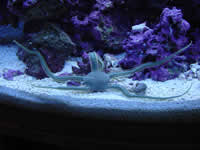 |
Starfish like
this Green Brittle Star should be avoided in a jawfish
aquarium. |
|
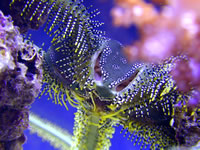
|
Is it any wonder why jawfish are uneasy around the presence
of Ophiarachna?
|
Fast or active swimming fish
should also be avoided. All surgeonfish, angelfish, and butterflies
fit into this category. Additionally, certain wrasses will
fall into this category. Any larger fish that darts or becomes
hyperactive during feeding may potentially cause problems.
If you want to keep your jawfish with any fish that fit into
this category, it is highly recommended that you never remove
your cover from the aquarium. Otherwise, in time, you will
find your jawfish on the floor.
Small gobies might be best kept in a different
tank unless they establish a homestead and don't wander far
from it. A jawfish does like to keep a perimeter around its
den, and will usually defend this perimeter against small
gobies. In my own observations, this occurred with my White-rayed
Shrimp Goby, (Stonogobiops, sp.). Occasionally, my
Shrimp Goby would venture nearby the den of my jawfish. Each
time, the jawfish would delicately grab the goby in its mouth
and remove it from his territory. Usually, this was roughly
12" away from the opening of the den. The first time
I saw this, I was astounded, fearing the un-timely death of
my rare goby! When the goby swam away, I began to breath easier.
This wasn't any easier to watch the second, third, or fourth
time, either. Eventually, it grew on me, and I found it comical.
Although not as often, yet often enough to note, the jawfish
would grab mouthfuls of sand and spit them at the "attacking"
goby. Again, no harm was done.
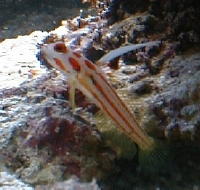 |
Gobies like this Stonogobiops sp. can become
a nuisance
to your jawfish.
So what fish make good tank mates for jawfish?
Cardinalfish, anthias, assessors, blennies, pipefish, and
dragonettes will do well. Most gobies and some wrasses will
also do well. The general criteria would be a passive, slow
moving fish that is nearly equal in size or smaller.
Mating and Spawning
Mating, spawning, and the rearing of jawfish
fry has been successful in home aquariums. A 4' tank is recommended
for the pair in so much as natural territories of jawfish
range from 1 - 3'. In spawning season (Spring through Fall),
sexual dichromatism is present in some species. The Yellow
head jawfish gains black spots on the ventral side of the
head, while the Blue spot jawfish's posterior becomes white.
Outside of spawning season there is no sexual dichromatism.
The mating ritual is different in each
species. However, the process usually begins in the dawn or
dusk of a full or new moon, with the male gaining the attention
of the female (Michael, Coral
Realm). If accepted, the female will follow her male counterpart
into his cave, or in some cases a third, neutral cave built
for the mating ritual. The egg clutch is first laid by the
female, then fertilized by the male. Much like Banggai Cardinals
(Pterapogon kauderni), male jawfish are mouth brooders.
The eggs are easily seen bulging from the male's mouth. When
Opistognathus aurifrons was studied, the eggs were
roughly .8mm in size, with an estimated 300 - 500 eggs in
the male's mouth. He incubates these eggs in his mouth for
7 - 9 days, after which time he releases the 4mm long fry.
Shortly after the male releases the fry, the ritual can be
repeated. At 15 days from release and 1.5cm long, the fry
take to the sand and begin digging their den. Within one year
they are full grown (Baensch, '94).
Raising the fry can prove to be tricky,
although it has been completed successfully. First foods offered
should be enriched Rotifers, to be followed by Artemia
nauplii when the fry are large enough to ingest them.
Meet the Species
As noted earlier, Opistognathus aurifrons,
or the Yellow head jawfish, is the most popular among hobbyists.
They are, after all, attractive, hardy, and inexpensive. The
attractiveness comes from the baby blue coloration throughout
their body and their beautiful yellow head. Reaching a maximum
size of 4", they originate from the tip of Florida and
are found throughout the Caribbean. In most cases they will
not bother invertebrates, although smaller ornamental shrimp
may be eaten. When spawning, the male will hover in the open
water and spread his fins wide and arch his body. Perhaps
to show his readiness to the female, he opens his large mouth,
and his head enlarges.
Second to O. aurifrons in popularity
only because of price, is the Blue spot jawfish, Opistognathus
rosenblatti. In general, expect a $100 price tag or more
for these beauties. The Blue spot is found in the Gulf of
California, usually at the base of cliffs. They reach 4"
in length. The mating ritual of these jawfish begins when
the posterior half of the fish becomes white. The male makes
repeated dashes into its den. To the on-looking diver, only
bright white flashes are seen. When not in spawning season,
the background color of the fish is generally brown, and in
some cases, a dirty yellow. Blue spots adorn the entire length
of the fish. These species are slightly more aggressive towards
each other, and a larger aquarium is recommended if you're
trying to keep a pair. In the wild, the pair can be up to
10' apart from each other.
Nearly an identical twin to O. rosenblatti
is Opistognathus panamensis, or the Panamanian jawfish.
It differs from O. rosenblatti only by the blue spots
and locale. In most cases, these spots are actually stripes,
and, as the name suggests, it originates from Panama.
Several jawfish are commonly referred to
as "Dusky jawfish." These would include Opistognathus
macrognathus, Opistognathus maxillosus, Opistognathus
scops, and Opistognathus whitehursti. Unlike the
jawfishes discussed above, these are not planktonic feeders.
They will consume small fish or shrimp if they fit into their
mouths. Also, unlike their cousins, they lack attractive patterns
or colors.
Also called a Spotfin, O. scops
is imported from the east Pacific, Baja California, and the
Galapagos. Overall, it is brown, with white spots throughout
the body and a black spot encircled with white on the dorsal
fin. These jawfish can get larger, up to 6". If you're
looking for a jawfish to house with moderately more aggressive
fish than that of the Yellow head or Blue spot, then this
one is for you.
Another jawfish commonly referred to as
the "Dusky" is O. whitehursti. It is the
smallest Opistognathus at 3" and thus requires
a quieter tank than the others. Like all other jawfish sold
under the "Dusky" name, it is not a planktonic feeder.
Shrimp should probably not be added to their aquarium unless
they are intended as a meal.
There are other Opistognathus not
mentioned. However, those generally don't get imported regularly
or they get too large to house in home aquariums, thus they
will not be discussed.
With their bug-like eyes and bucket-like
mouths, jawfish win their way into most hobbyists' hearts.
Their personality and hardiness are commendable. All too often,
however, jawfish take the rap for destructive tendencies.
In most cases the destructive habits are the fault of the
hobbyist ignoring the needs of the jawfish.
|

